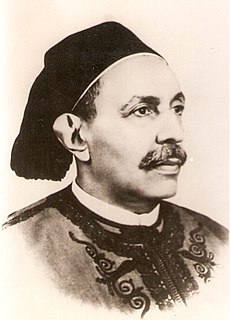| Muhammad ibn Ali as-Senussi | |
|---|---|
| Founder of the Senussi dynasty | |
| Successor | Prince Muhammad |
| Born | 1787 Mostaganem, |
| Died | 1859 Jaghbub, Libya, |
| House | Senussi |
| Father | Sayyid Ali as-Senussi |
| Religion | Islam |
Muhammad ibn Ali as-Senussi in full Sīdī Muḥammad ibn ʿAlī al-Sanūsī al-Mujāhirī al-Ḥasanī al-Idrīsī, (1787–1859) was an Arab Muslim theologian and leader who founded of the Senussi mystical order in 1837. His militant mystical movement proved very significant and helped Libya to win its freedom from Italy on 10 February 1947. Omar Mukhtar was one of the most significant leader of Senussi military campaign launched by Muhammad ibn Ali as-Senussi. Al-Sanūsī’s grandson Idrīs I ruled as king of Libya from 1951 to 1969. [1]

The Senussi or Sanusi are a Muslim political-religious tariqa and clan in colonial Libya and the Sudan region founded in Mecca in 1837 by the Grand Senussi, the Algerian Muhammad ibn Ali as-Senussi. Senussi was concerned with what he saw as both the decline of Islamic thought and spirituality and the weakening of Muslim political integrity.

Libya, officially the State of Libya, is a country in the Maghreb region in North Africa, bordered by the Mediterranean Sea to the north, Egypt to the east, Sudan to the southeast, Chad to the south, Niger to the southwest, Algeria to the west, and Tunisia to the northwest. The sovereign state is made of three historical regions: Tripolitania, Fezzan and Cyrenaica. With an area of almost 1.8 million square kilometres (700,000 sq mi), Libya is the fourth largest country in Africa, and is the 16th largest country in the world. Libya has the 10th-largest proven oil reserves of any country in the world. The largest city and capital, Tripoli, is located in western Libya and contains over one million of Libya's six million people. The second-largest city is Benghazi, which is located in eastern Libya.

ʿOmar al-Mukhṭār Muḥammad bin Farḥāṭ al-Manifī, called The Lion of the Desert, known among the colonial Italians as Matari of the Mnifa, was the leader of native resistance in Cyrenaica, currently Eastern Libya under the Senussids, against the Italian colonization of Libya. A teacher-turned-general, Omar was also a prominent figure of the Senussi movement, and he is considered the national hero of Libya and a symbol of resistance in the Arab and Islamic worlds. Beginning in 1911, he organised and, for nearly twenty years, led the Libyan resistance movement against the colonial Italians during the Pacification of Libya. After many attempts, the Italian Armed Forces managed to capture Al-Mukhtar near Solonta and hanged him in 1931.

















